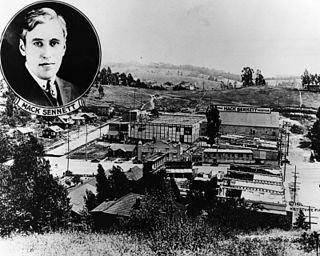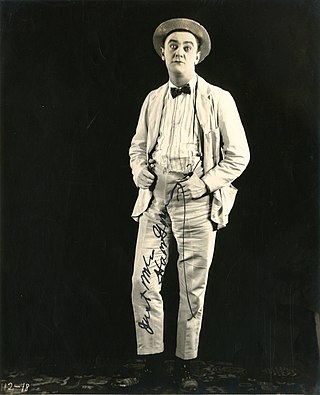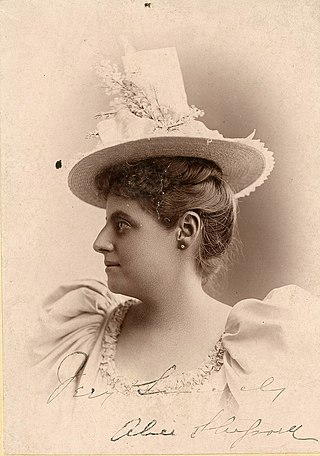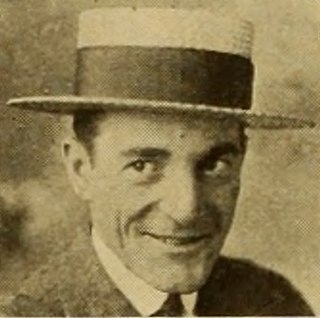
Mack Sennett was a Canadian-American producer, director, actor, and studio head who was known as the "King of Comedy" during his career.

Tillie's Punctured Romance is a 1914 American silent comedy film directed by Mack Sennett and starring Marie Dressler, Mabel Normand, Charlie Chaplin, and the Keystone Kops. The picture is the first feature-length comedy and was the only feature-length comedy made by the Keystone Film Company.

Amabel Ethelreid Normand, better known as Mabel Normand, was an American silent film actress, director and screenwriter. She was a popular star and collaborator of Mack Sennett in their Keystone Studios films, and at the height of her career in the late 1910s and early 1920s had her own film studio and production company, the Mabel Normand Feature Film Company. On screen, she appeared in twelve successful films with Charlie Chaplin and seventeen with Roscoe "Fatty" Arbuckle, sometimes writing and directing films featuring Chaplin as her leading man.

Keystone Studios was an early film studio founded in Edendale, California on July 4, 1912 as the Keystone Pictures Studio by Mack Sennett with backing from actor-writer Adam Kessel (1866–1946) and Charles O. Baumann (1874–1931), owners of the New York Motion Picture Company. The company, referred to at its office as The Keystone Film Company, filmed in and around Glendale and Silver Lake, Los Angeles for several years, and its films were distributed by the Mutual Film Corporation between 1912 and 1915. The Keystone film brand declined rapidly after Sennett went independent in 1917.

Mack Swain was a prolific early American film actor, who appeared in many of Mack Sennett’s comedies at Keystone Studios, including the Keystone Cops series. He also appeared in major features by Charlie Chaplin and starred in both the world's first feature length comedy and first film to feature a Movie-within-a-movie premise.

Ford Sterling was an American comedian and actor best known for his work with Keystone Studios. One of the 'Big 4', he was the original chief of the Keystone Cops.

Chester Cooper Conklin was an early American film comedian who started at Keystone Studios as one of Mack Sennett’s Keystone Cops, often paired with Mack Swain. He appeared in a series of films with Mabel Normand and worked closely with Charlie Chaplin, both in silent and sound films.
Edendale is a historical name for a district in Los Angeles, California, northwest of Downtown Los Angeles, in what is known today as Echo Park, Los Feliz and Silver Lake. In the opening decades of the 20th century, in the era of silent movies, Edendale was known as the home of most major movie studios on the West Coast. Among its many claims, it was home to the Keystone Kops, and the site of many movie firsts, including Charlie Chaplin's first movie, the first feature-length comedy, and the first pie-in-the-face. The Edendale movie studios were mostly concentrated in a four-block stretch of Allesandro Street, between Berkeley Avenue and Duane Street. Allesandro Street was later renamed Glendale Boulevard.

Hank Mann was a Russian Empire-born and American comedian and silent screen star who was a member of the Keystone Cops, and appeared as a supporting player in many of Charlie Chaplin's films.

Slim Summerville was an American film actor and director best known for his work in comedies.

Alice Howell was a silent film comedy actress from New York City. She was the mother of actress Yvonne Howell.

Harry Peter Gribbon was an American film actor, comedian and director known for The Cameraman (1928), Show People (1928) and Art Trouble (1934). He appeared in more than 140 films between 1915 and 1938. Many of his films from this era have been lost.

Alice Davenport was an American film actress. She appeared in 140 films from 1911 to 1930.

Glenn W. Cavender was an American film actor. He appeared in more than 250 films between 1914 and 1949.

Charles Albert Murray, was an American film actor of the silent era.

George Nichols, sometimes credited in films as George O. Nicholls, was an American actor and film director. He is perhaps best remembered for his work at Mack Sennett's Keystone Studios.

Al St. John (1893–1963) was an American comic actor who appeared in 394 films between 1913 and 1952. Starting at Mack Sennett's Keystone Film Company, St. John rose through the ranks to become one of the major comedy stars of the 1920s, though less than half of his starring roles still survive today. With the advent of sound drastically changing and curtailing the two-reel comedy format, St. John diversified, creating a second career for himself as a comic sidekick in Western films and ultimately developing the character of "Fuzzy Q. Jones", for which he is best known in posterity.

Hugh Fay was an American comedic actor and director. He appeared in vaudeville and silent films.
Ethel "Dixie" Chene was an American film actress active during Hollywood's silent era. She was primarily known for appearing in Mack Sennett's Keystone comedies.
Bert Hunn was an American actor who starred in silent films in the 1910s.


















